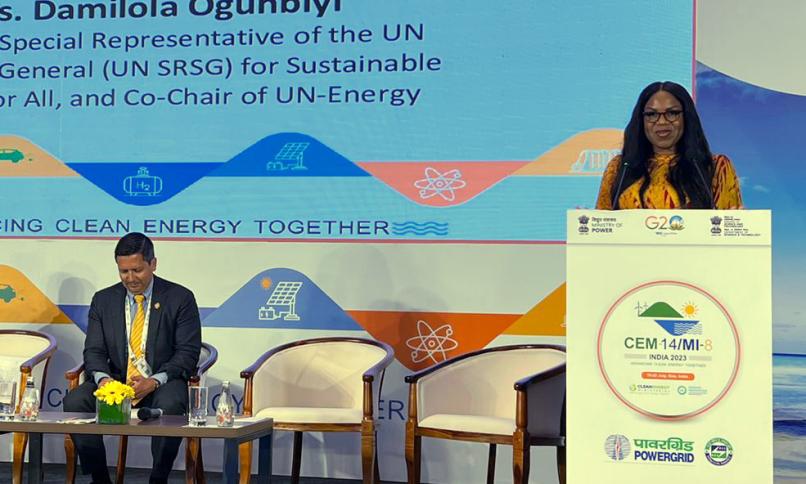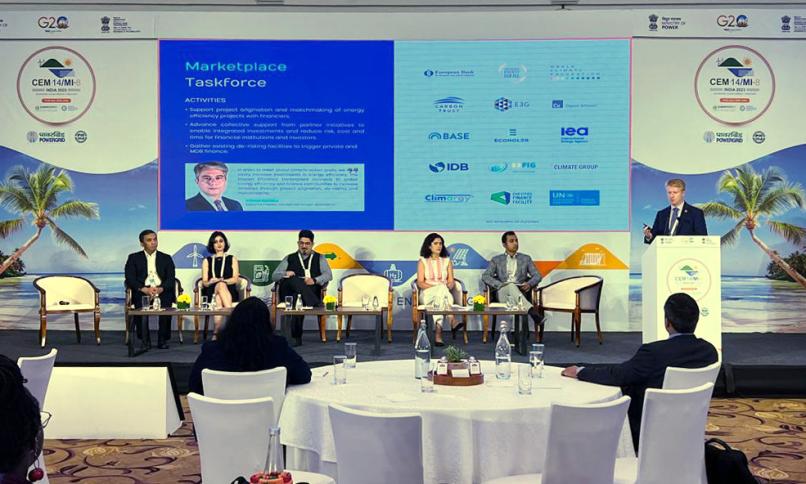Mission Efficiency roundtable at CEM builds momentum for investment in energy efficiency with ‘marketplace’ approach
Mission Efficiency and SEforALL organized a roundtable at the 14th Clean Energy Ministerial (CEM) in Goa, India last month to strengthen collaboration opportunities between both actors. Mission Efficiency stands as an energy efficiency ecosystem that elevates energy efficiency in energy, climate, and development agendas, supports progress in key sectors and economy-wide, and increases investment in energy efficiency.
By combining Mission Efficiency and CEM collective knowledge, expertise, and resources, we can leverage strengths to amplify the impact of CEM through the power of energy efficiency. The event convened strategic philanthropy, countries and energy efficiency partners to find ways to enhance collaboration, notably by expanding the Mission Efficiency marketplace for energy efficiency projects to CEM countries and initiatives. The Mission Efficiency Marketplace is a one-of-a-kind platform that mobilizes finance from various sources, including public, private, philanthropic, bilateral, and multilateral institutions. This is achieved by identifying sector priorities for energy efficiency interventions, de-risking projects and matching projects with investors and finance providers.
This strategic discussion couldn't have come at a more opportune moment, as India continues to demonstrate its remarkable leadership on energy efficiency, a journey which started with the enactment of the Energy Conservation Act in 2001, and the establishment of the Bureau of Energy Efficiency (BEE) under the Ministry of Power. Today, India continues to showcase its determination to work in coordination with the international community to address pressing need to improve energy efficiency.
During the roundtable, Damilola Ogunbiyi, CEO and Special Representative of the UN Secretary-General for Sustainable Energy for All, and Co-Chair of UN-Energy, noted that by investing in energy efficiency we can power progress on SDG7, power climate progress, and power modern lives and livelihoods. She also called on partners to use Mission Efficiency to elevate energy efficiency in the development agenda, support global progress and increase energy efficiency investments.
The roundtable’s distinguished participants provided a range of valuable insights on both the topic of collaboration and investing in energy efficiency, including:
“There is an opportunity to work together to exchange best practices, policy experiences, data, and mobilize more coordinated resources and technical assistance, particularly in the Global South. We also have an opportunity to build on the LiFE and make energy efficiency a global movement and a shared mission,” said Mr. Arijit Sengupta Director at the Bureau of Energy Efficiency, Ministry of Power, Government of India.
“Energy efficiency offers the largest gains and the highest rewards. CEM and Mission Efficiency can help put that notion on the global agenda and break down the myth of high risk of investing in the Global South,” said Mr. Tomas Anker Christensen, Climate Ambassador, Ministry of Foreign Affairs of Denmark, emphasizing the close links between energy efficiency and cooling.
“Country collaboration and international collaboration is very important for energy efficiency particularly in emerging economies,” pointed out Mr. Gigih Udi Utomo, Director, Energy Conservation, Ministry of Energy and Mineral Resources, Indonesia.
“The Marketplace provides a way to bind and aggregate projects and provide an opportunity for reducing risk and transaction costs” said Mr. Vishal Kapoor, CEO, Energy Efficiency Services Limited.
“We need to work on the sequence elevate, support, invest. Bringing together more experiences from CEM and putting them in the spotlight can help elevate energy efficiency, like it has been done with the Energy Management Leadership Awards. We should make investments in clean energy conditional to a certain energy efficiency benchmark,” said Ms. Rana Ghoneim, Chief, Energy System and Infrastructure Division, UNIDO.
“Collaboration efforts should involve financial institutions, working with governments to identify country priorities that guide investment, including sub-national levels, where important lessons and experiences can be leveraged on,” said Ms. Saumya Malhotra, Programme Officer at the Climate, Children's Investment Fund Foundation.
“If you see the deployment of capital for energy efficiency, philanthropy capital is the smallest, but it can be very strategic for bringing multiple stakeholders together, leveraging investment, de-risking investments and making these collaborations more meaningful,” said Mr. Amit Khare from the Sequoia Climate Foundation.
“In the last few years, we have moved from aspirational goals to actioning. The nature of international collaboration has undergone a lot of change, gradually calling for efforts at sub-national level and deliver action on the ground. There is a very strong synergy between the Mission Efficiency call to action and the work of CEM,” said Mr. Sarbojit Pal, Manager of Partnerships at Clean Energy Ministerial.
This discussion highlights the synergy and alignment between CEM and Mission Efficiency in delivering action at national and subnational levels and across various sectors. It also paves the way for closer collaboration, facilitating the integration of the Mission Efficiency marketplace to CEM countries and initiatives. Mission Efficiency partners will use the Marketplace approach in key countries including India, Ghana and Kenya in the months ahead and look to leverage partnership with CEM and G20 nations to increase investment in efficient solutions.




